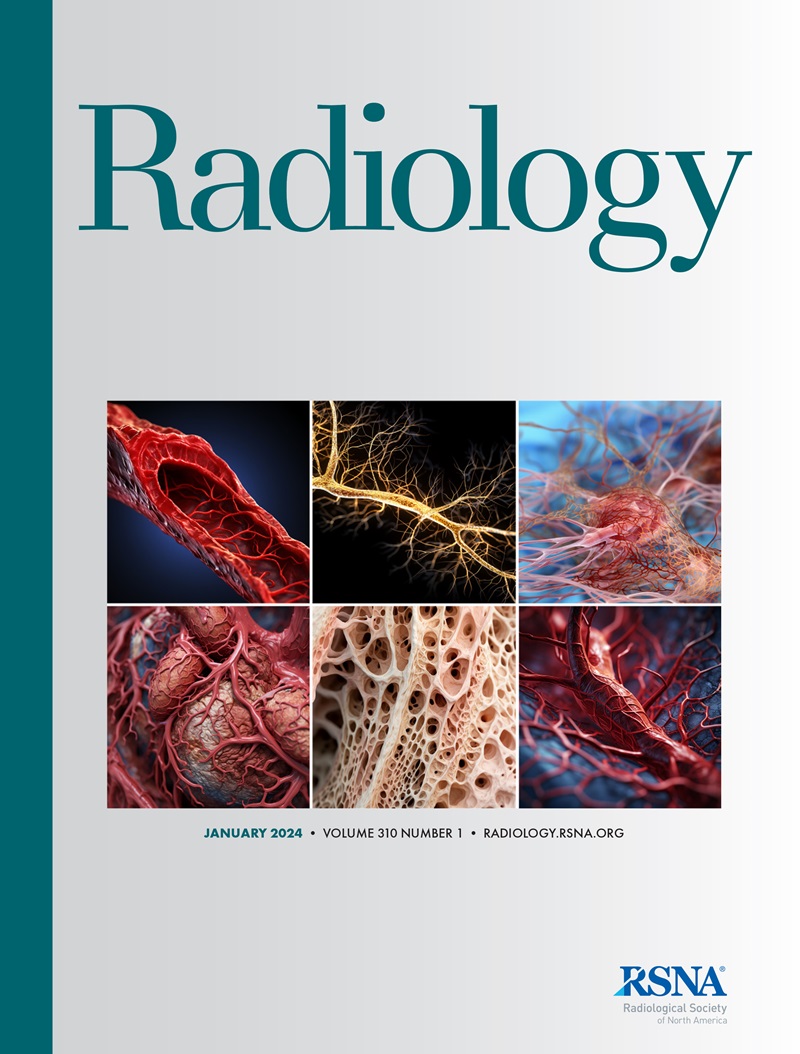求助PDF
{"title":"Hormonal Regulation of Background Parenchymal Enhancement at Contrast-enhanced Mammography.","authors":"Noam Nissan, Varadan Sevilimedu, Jill Gluskin, Yuki Arita, Delia M Keating, Donna D'Alessio, Hila Fruchtman-Brot, R Elena Ochoa-Albiztegui, Janice S Sung, Maxine S Jochelson","doi":"10.1148/radiol.241158","DOIUrl":null,"url":null,"abstract":"<p><p>Background Background parenchymal enhancement (BPE) is an important diagnostic and prognostic imaging biomarker. Although hormonal regulation of BPE at breast MRI has been investigated, information regarding hormonal regulation of BPE at contrast-enhanced mammography (CEM) remains scarce. Purpose To investigate how BPE at CEM changes across various short- and long-term physiologic and pharmacologic hormonal effects, including menopausal status, lactation, hormone replacement therapy (HRT), and tamoxifen therapy and its cessation. Materials and Methods This retrospective study included CEM examinations performed between December 2012 and January 2024. A computational search was performed to identify CEMs performed in patients with various hormonal statuses and several subgroups of patients were identified, including premenopausal, postmenopausal, lactating, HRT, and tamoxifen subgroups. For patients who received tamoxifen therapy, the first follow-up image at treatment cessation was included, when available. The four ordinal BPE grades, ranging from minimal to marked, as reported in the official radiologic reports were used for analysis. Subgroup comparisons were performed using the Kruskal-Wallis rank sum test and χ<sup>2</sup> test or Fisher exact test. Results A total of 507 female patients (mean age, 49.8 years ± 10.8 [SD]; range, 25-75 years) were included. Premenopausal patients (<i>n</i> = 200) exhibited higher BPE compared with postmenopausal patients (<i>n</i> = 200) (median grade, 1.0 [IQR, 0-2.0] vs 0 [IQR, 0-1.0]; <i>P</i> < .001). Lactating patients (<i>n</i> = 16) exhibited higher BPE (median grade, 3.0; IQR, 2.0-3.0) compared with nonlactating controls (median grade, 1.0; IQR, 0-2.0; <i>P</i> < .001). Patients receiving HRT (<i>n</i> = 14) exhibited higher BPE (median grade, 1.5; IQR, 0-3.0) compared with postmenopausal controls (median grade, 0; IQR, 0-1.0; <i>P</i> < .001). Patients receiving tamoxifen therapy (<i>n</i> = 77) exhibited lower BPE (median grade, 1.0; IQR, 0-2.0) compared with nontreated control patients (9% of patients with high BPE vs 31% for controls, <i>P</i> < .001) and increased BPE (median grade, 2.0; IQR, 1.5-2.5; <i>P</i> = .003) at the cessation of tamoxifen therapy. Conclusion Hormonal effects, including menopausal status, lactation, HRT, and tamoxifen therapy, influenced the degree of BPE at CEM. © RSNA, 2025 <i>Supplemental material is available for this article.</i> See also the editorial by Slanetz in this issue.</p>","PeriodicalId":20896,"journal":{"name":"Radiology","volume":"314 2","pages":"e241158"},"PeriodicalIF":12.1000,"publicationDate":"2025-02-01","publicationTypes":"Journal Article","fieldsOfStudy":null,"isOpenAccess":false,"openAccessPdf":"","citationCount":"0","resultStr":null,"platform":"Semanticscholar","paperid":null,"PeriodicalName":"Radiology","FirstCategoryId":"3","ListUrlMain":"https://doi.org/10.1148/radiol.241158","RegionNum":1,"RegionCategory":"医学","ArticlePicture":[],"TitleCN":null,"AbstractTextCN":null,"PMCID":null,"EPubDate":"","PubModel":"","JCR":"Q1","JCRName":"RADIOLOGY, NUCLEAR MEDICINE & MEDICAL IMAGING","Score":null,"Total":0}
引用次数: 0
引用
批量引用
Abstract
Background Background parenchymal enhancement (BPE) is an important diagnostic and prognostic imaging biomarker. Although hormonal regulation of BPE at breast MRI has been investigated, information regarding hormonal regulation of BPE at contrast-enhanced mammography (CEM) remains scarce. Purpose To investigate how BPE at CEM changes across various short- and long-term physiologic and pharmacologic hormonal effects, including menopausal status, lactation, hormone replacement therapy (HRT), and tamoxifen therapy and its cessation. Materials and Methods This retrospective study included CEM examinations performed between December 2012 and January 2024. A computational search was performed to identify CEMs performed in patients with various hormonal statuses and several subgroups of patients were identified, including premenopausal, postmenopausal, lactating, HRT, and tamoxifen subgroups. For patients who received tamoxifen therapy, the first follow-up image at treatment cessation was included, when available. The four ordinal BPE grades, ranging from minimal to marked, as reported in the official radiologic reports were used for analysis. Subgroup comparisons were performed using the Kruskal-Wallis rank sum test and χ2 test or Fisher exact test. Results A total of 507 female patients (mean age, 49.8 years ± 10.8 [SD]; range, 25-75 years) were included. Premenopausal patients (n = 200) exhibited higher BPE compared with postmenopausal patients (n = 200) (median grade, 1.0 [IQR, 0-2.0] vs 0 [IQR, 0-1.0]; P < .001). Lactating patients (n = 16) exhibited higher BPE (median grade, 3.0; IQR, 2.0-3.0) compared with nonlactating controls (median grade, 1.0; IQR, 0-2.0; P < .001). Patients receiving HRT (n = 14) exhibited higher BPE (median grade, 1.5; IQR, 0-3.0) compared with postmenopausal controls (median grade, 0; IQR, 0-1.0; P < .001). Patients receiving tamoxifen therapy (n = 77) exhibited lower BPE (median grade, 1.0; IQR, 0-2.0) compared with nontreated control patients (9% of patients with high BPE vs 31% for controls, P < .001) and increased BPE (median grade, 2.0; IQR, 1.5-2.5; P = .003) at the cessation of tamoxifen therapy. Conclusion Hormonal effects, including menopausal status, lactation, HRT, and tamoxifen therapy, influenced the degree of BPE at CEM. © RSNA, 2025 Supplemental material is available for this article. See also the editorial by Slanetz in this issue.


